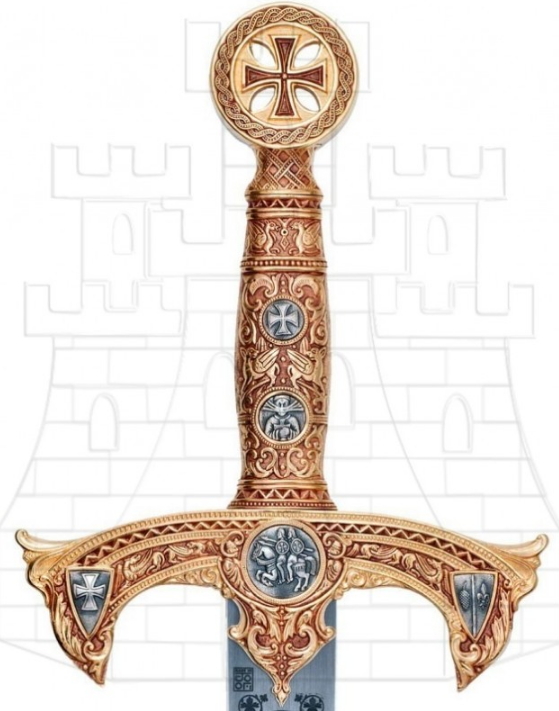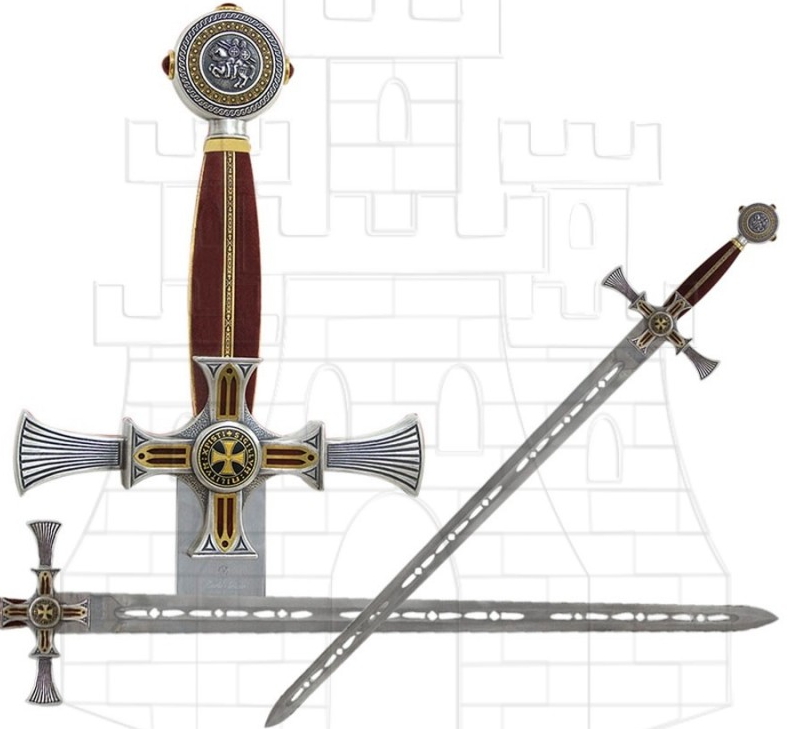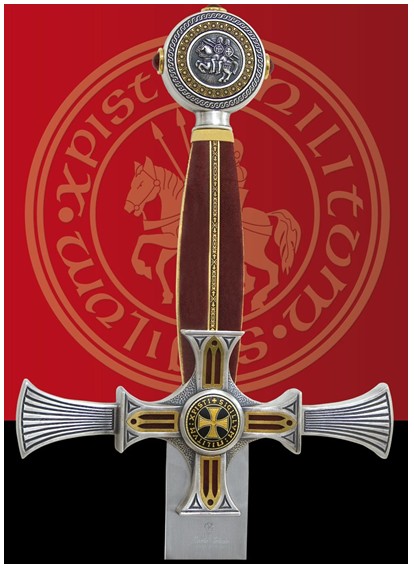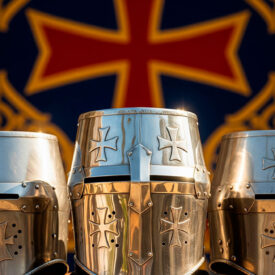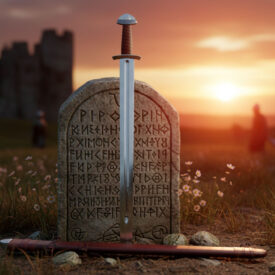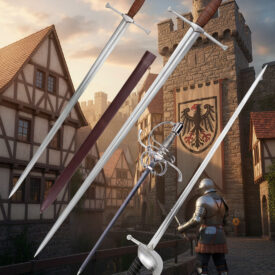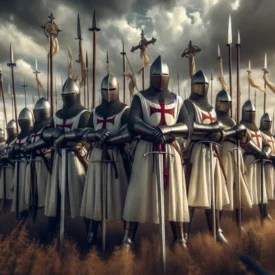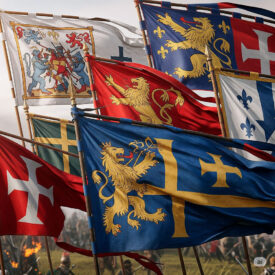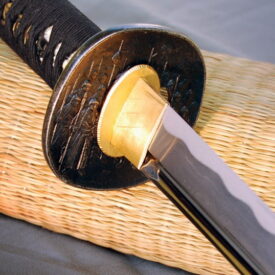When we think of the Knights Templar, it’s common for the image of warriors in their characteristic white tabards and, of course, an imposing large sword to come to mind. The Order of the Temple, officially known as the Poor Fellow-Soldiers of Christ and of the Temple of Solomon, was one of the most renowned Christian military orders of the Middle Ages, active for nearly two centuries until its suppression in 1312. Its legacy is steeped in battlefield bravery and deep religious devotion.
But how accurate is that popular image of the Templar sword? In this article, we’ll explore the fascinating history of these iconic weapons, separating myth from reality and revealing the true meaning the sword held for these monk-warriors. We’ll delve into the characteristics of the real historical swords they wielded, debunk some popular beliefs, and guide you to understand their symbolism and, if you’re interested, how to acquire a quality replica, whether decorative swords or functional swords.
The Motto That Guided Their Path
A fundamental aspect to understanding the Templars is their motto: “Non Nobis, Domine, Non Nobis, Sed Tuo Nomini Da Gloriam.” This phrase, translated as “Glory, not for us, Lord, not for us, but for your name,” encapsulated their humility and unwavering dedication to divine service in every action they undertook. This gives us a first clue about their mindset: their tools, including the sword, were at the service of a higher purpose. For a Templar knight, his sword was not just a weapon of war, but an extension of his faith and his commitment to divine justice.
Debunking a Myth: The Swords the Templars Did NOT Use
It’s time to debunk one of the most widespread ideas, fueled by cinematic fiction: the Templars did not commonly use “longswords” (also known as hand-and-a-half swords, bastard swords, or two-handed swords). This belief, popularized by movies and fiction, drastically contrasts with historical evidence. The famous swords of popular culture often distort the reality of medieval weaponry.
Temporal and Geographical Anachronism
Longswords, as we know them in their most developed and popular form, were born and became widespread in the 14th century, specifically in its second half. This is after the dissolution of the Order of the Temple in 1312. Furthermore, their origin and main use were in Central Europe (especially Germany), not in the Middle East or the Iberian Peninsula, where the Templars had a significant presence. Any such innovation would have reached the Iberian Peninsula much later and would not have been the type of sword a Templar knight would have carried on campaign.
Evolution of Armor and Combat Style
During the period of the Order of the Temple (12th-13th centuries), the predominant armor was chain mail, which could be effectively penetrated by one-handed swords with sharp points. Warriors of the time used one hand for the sword and the other to hold a large shield. This shield was not only excellent defense, capable of blocking arrows, but was also fundamental in the shield wall tactic employed by the Templars on foot. A two-handed sword would be useless in this formation, as it would break cohesion and not offer the same protection. The combat tactics of the Templar knights were based on coordination and group defense, where agility and shield protection were paramount.
Lack of Tradition and Regulation
There are no records of weapons masters of the time teaching “longsword” techniques. The first known treatise on the hand-and-a-half sword dates from 1389, long after the existence of the Temple. Furthermore, the Order of the Temple had a highly regulated combat system and would not have allowed a weapon lacking an established technique or unsuitable for their tactics. In cavalry charges, for example, there was no place for longswords. Discipline and uniformity in weaponry were crucial for the effectiveness of the Templar knights on the battlefield.
Lack of Documentary and Graphic Evidence
Simply put, there is not a single piece of evidence in documentary sources or contemporary graphic representations showing the Templars using longswords. They always appear with their classic attributes: spear and shield, or a one-handed sword. This absence of evidence is one of the strongest reasons to refute the myth of the “great Templar sword” as a two-hander.
The True Weapons of the Templar
So, what swords did the Templars actually use? Like most knights of their time, they were equipped with swords that were conventional and common for the era. This mainly included one-handed swords, sometimes called “arming swords” when used on horseback, always combined with a shield. Their armament also included spears, maces, and daggers, each with its specific function in combat. The Templars were trained for combat, often with previous military experience, and their equipment was designed to be effective and decisive in battle. The sword was a vital tool, but not the only one, and its design responded to the tactical needs and armor type of the time.
The Templar swords were not only used for attack and defense, but were the faithful companion of the Templar knight in daily life. They had a cross-shaped hilt, a straight, double-edged, pointed blade, designed and made with hardened, tough, and resistant steel that allowed penetration through enemy chain mail.
The total weight of the Templar sword was about one and a half kilos, and although the idea that it was wielded with two hands like a “greatsword” has become popular, the reality is that its balance, perfect at four fingers from the hilt, made it an extraordinarily effective weapon to be used with one hand, both for attack and defense. This was especially useful against the curved and short weapons of Arab warriors, such as scimitars, allowing the Templar knight to keep his shield raised. This type of sword, robust and well-balanced, was the true knight’s sword of the era.
Beyond the Blade: The Deep Symbolism of the Templar Sword
Although it was not the “longsword” of legend, the Templar sword was undoubtedly a powerful symbol of their status and values. More than just a tool of war, it embodied the essence of these divinely inspired warriors. Its shape and use were imbued with deep spiritual meaning, transcending its practical function in combat. The Templar cross, often engraved on the hilt, reinforced this symbolism.
- Spiritual Strength and Authority: It reflected the spiritual strength of the knight and the authority of the wielder, embodying higher ideals. It was a constant reminder of their oath and purpose.
- Templar Virtues: It concentrated virtues such as honor, courage, power, truth, righteousness, balance, and charity. Every blow and every defense with the sword was an act of faith and virtue.
- Purification and Knowledge: Associated with light and fire, its use was a purification. The “flaming sword” symbolized pure knowledge and the destruction of ignorance, illuminating the path of the Templar knight.
- Axis Mundi: The Templar sword could be considered an “Axis Mundi,” a point of connection between heaven and earth, in relation to higher principles. It was the bridge between the earthly and the divine.
- Fight for Justice: The Templar swords bore inscriptions reflecting their purpose: “Draw me not without reason, sheathe me not without honor” and “Use me not without justice, keep me not without honor.” This underlines their unwavering commitment to justice and peace, even in war.
- The “Temperance” of the Soul: The act of “tempering” a sword referred not only to the process of hardening metal, but also to the inner perfection of the knight. It represented the continuous balance with divine laws and the purification of the soul, fundamental for the monk-warrior. A Templar had to “temper” his soul not to succumb to the difficulties of life, becoming a support for his companions.
- Victory over Evil: Its cross shape symbolized Christ’s victory over death and the knight’s duty to defeat and destroy the enemies of the faith. The sword was, in essence, a crucifix on the battlefield.
The Knights Templar not only took the path of religion, but also the path of arms for altruistic purposes, to protect the weakest and defend human values, in a path of sacrifice and renunciation that only monks and warriors could undertake. Their commitment to the Templar cross was absolute.
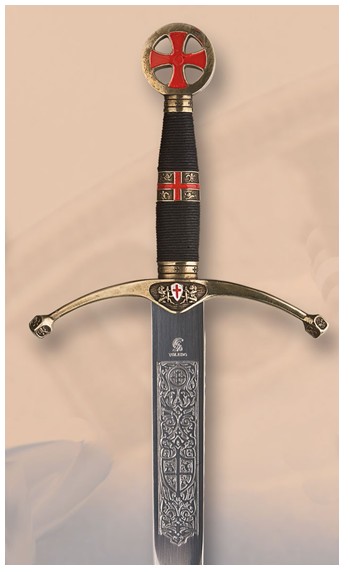
Sword of the Crusader Knights
Literature, great deeds, and especially the Hollywood film industry have always turned to the theme of the Templars because box office success is guaranteed. It’s a topic that “will never go out of style” and about which many legends, many lies, and many truths have been told, often creating a distorted image of the famous swords and real historical swords of the era.

Sword of the Knights of Heaven
The “Milites Templi” was the great Military Order of the Temple founded in 1119 by noble French knights, led by their first Grand Master, Hugues de Payens, as a charitable brotherhood with monastic vows, to which a military vow was added, to defend pilgrims in Jerusalem. Baldwin II of Jerusalem gave them a residence located on the site of the ancient Temple of Solomon, thus adopting the name Templars. The Templar sword became a symbol of this new militia.
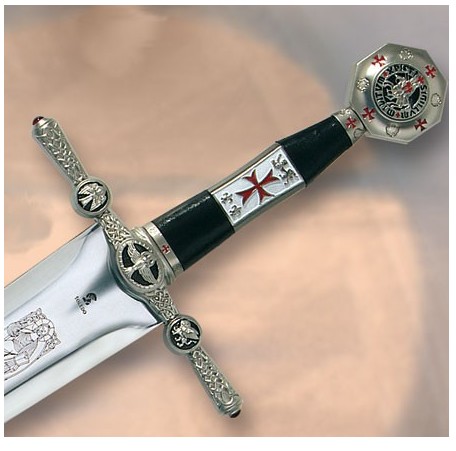
Sword of the Grand Master of the Temple
In 1127, the order was recognized by Pope Honorius III, and the following year, under the protection of the Cistercians, it adopted a modified version of the Benedictine rule. Thanks to the patronage of Saint Bernard, who dedicated his famous “De laude nova militiae ad milites Templi” to them, the Templars obtained important donations and growing social, economic, and spiritual influence. The image of the Templar knights’ sword became the banner of this powerful order.
Types of Swords and Their Relevance for Medieval Knights
While the image of the Templar sword is iconic, it’s crucial to understand that there was not a single “type” of sword exclusive to the Order. The Templar knights, like other warriors of their time, used the most effective and common weapons available. The evolution of metallurgy and forging techniques influenced the quality and design of each sword, from the most basic to those with an intricate damascus pattern.
One-Handed Swords (Arming Swords): The True Companion
One-handed swords, often called “arming swords” or knight’s swords, were the most prevalent during the Templar period (12th and 13th centuries). These swords were characterized by their manageable length (approximately 70-90 cm blade), light weight (between 1 and 1.5 kg), and design intended for one-handed use, leaving the other hand free for the shield. Their blade was straight, double-edged, and with a sharp point, ideal for thrusting through chain mail or for cutting in close combat. They were the true functional swords of the era, adapted to combat tactics both on foot and on horseback. The hilt was usually simple, with a straight guard and a pommel often shaped like a disc or nut, providing a counterweight and a support point for the hand.
The Damascus Blade: Art, Legend, and Resilience
When we talk about a damascus sword, we refer to a type of steel with a distinctive pattern resembling wood or water veins. This pattern was not just aesthetic; it was the result of a complex forging process that combined different types of steel to obtain a blade with exceptional hardness at the edge and flexibility to avoid breaking. Damascus swords were highly valued for their resilience and ability to maintain a sharp edge. Although true Damascus steel (Wootz) came from India and was worked in the Middle East, European “pattern-welded damascus” techniques sought to emulate these properties. While not all Templar swords were made of damascus, high-quality ones certainly benefited from advanced forging techniques seeking similar properties, making these swords true functional works of art.
Functional Swords vs. Decorative Swords: A Crucial Distinction
Today, the market offers a wide variety of Templar swords. It’s essential to distinguish between functional swords and decorative swords. Functional swords are designed and built to withstand real use, whether in historical reenactments, historical martial arts practice, or simply for those who appreciate the engineering of an authentic sword. These are usually made of high-quality steels, properly tempered and forged, with superior balance and durability. Their price is usually higher due to the workmanship and materials.
On the other hand, decorative swords are mainly intended for display. They can be impressive replicas in appearance, but are not built to withstand impacts or stress. They are often made of softer steels or alloys that have not been heat-treated for combat. Their price is generally more accessible, making them popular for collectors or to decorate spaces. It’s important to know this difference when looking for a Templar sword, especially if you’re looking for a Templar cadet sword to start a collection or study.
The Sword Scabbard: Protection and Portability
The sword scabbard was an essential component of any knight’s equipment. Beyond its aesthetic function, the scabbard protected the sword blade from the elements (moisture, dirt) and kept it safe from damage. It also allowed the knight to carry his sword safely and comfortably, whether hanging from the belt or tied to the saddle. Scabbards were usually made of wood covered with leather, often reinforced with metal fittings at the mouth and tip. For a Templar sword scabbard, functionality and durability were paramount, ensuring the sword was always ready for service.
Damascened Templar Sword
Famous and Historical Swords Associated with the Templar Era
Although there is no specific sword that can be directly attributed to an individual Templar knight and that has gone down in history as one of the famous swords or historical swords with its own name, the type of sword used by the Templars was common to many knights of the Crusades era. We can talk about historical swords that, by their design and use, would have been very similar to those wielded by the monk-warriors. These swords were the standard of European cavalry, designed for effectiveness in combat and durability in prolonged campaigns. Their design, with a straight blade and a cross-shaped hilt, became an archetype of the medieval knight’s sword.

Templar Sword in Silver
A Legacy That Transcends the End
The dissolution of the Order of the Temple in 1312, largely driven by the greed of the French king Philip IV and the weakness of Pope Clement V, turned the Templars into an enduring myth. Although the accusations of heresy, idolatry, and sodomy that led to their end were mostly false and obtained under torture, the resistance they offered in the Hispanic kingdoms (Castile and Aragon) contrasted notably with that of France. There, the Templars, with the support of the population, fortified themselves in their castles and proclaimed their innocence until the end. Even the provincial council of Salamanca declared them innocent, as did that of Tarragona in 1312.
This brave and often heroic resistance consolidated their image as innocent martyrs in the eyes of the people, a posthumous recognition rarely given elsewhere in Europe. The history of the Templars, with its lights and shadows, continues to resonate, reminding us of the complex interaction between power, faith, and the perpetual pursuit of justice. Their sword, beyond its physical form, remains a powerful symbol of an ideal of life and a legacy that endures in collective memory. The Templar cross, inseparable from their image, continues to inspire.
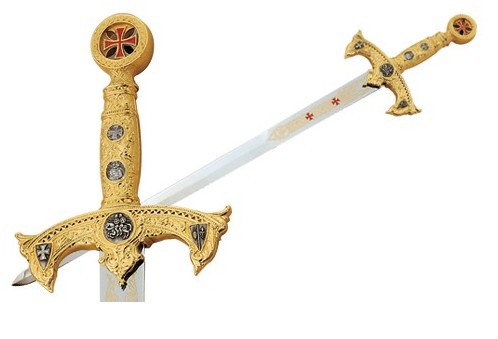
Templar Sword in Gold
In the Crown of Aragon, both the Temple and the Hospital had an active presence, with the so-called Order of Montesa being founded in 1317 with the goods confiscated from the Templars. In the Western kingdoms, on the other hand, native orders, which appeared in the second half of the 12th century, were always much more important.
Also, in Castile, the Order of Calatrava was founded in 1158, whose statutes, approved in 1164, made it dependent on the Cistercian abbey of Morimond. In León, the Orders of Alcántara (1156), also of Cistercian affiliation, and Santiago (1161), associated with the congregation of canons of Saint Eloy, emerged. As for Portugal, the Order of Saint Benedict of Avis was founded in 1162 and in 1319 the so-called Order of Christ. All these orders, like the Templars, depended on the sword as their main tool of defense and attack.
Buying Recommendations: How to Choose Your Templar Sword
If the history and symbolism of the Templar sword have captivated you, you may be considering acquiring one. Today’s market offers a vast range of options, from historically accurate replicas to purely decorative pieces. Understanding your needs and the use you will give the sword is key to making the best decision, and for this, price will be a determining factor.
For the Collector and History Lover (Decorative Swords)
If your main interest is display and aesthetic appreciation, decorative swords are an excellent option. These replicas seek to capture the visual essence of historical swords, often with a high level of detail in the hilt, guard, and pommel, which may incorporate the Templar cross or other motifs. Look for pieces with good finishes, materials that simulate the originals (even if not functional), and meticulous attention to form. The price of these swords can vary considerably, from affordable options to high-end replicas that are true works of art. They are ideal for decorating your home, office, or study space, and for those who want to own a piece of history without the need for combat functionality.
For the Reenactor or Practitioner (Functional Swords)
For those seeking a Templar sword for historical reenactment, martial arts practice, or training, it is essential to opt for functional swords. These swords are forged from high-carbon steels (such as damascus steel or 1060, 1075, 5160, etc.), heat-treated to provide the hardness and flexibility needed to withstand impacts. They must have proper balance, robust construction, and, in many cases, unsharpened edges for greater safety in practice. Pay attention to blade quality, hilt solidity, and how it feels in the hand. The price of functional swords is significantly higher than that of decorative ones, reflecting the investment in materials and the complexity of the forging and tempering process. A good sword scabbard is also crucial for transport and preservation.
Considerations on the Price of a Templar Sword
The price of a Templar sword can vary widely, from less than 100 euros for purely decorative mass-produced models, to several thousand euros for functional replicas hand-forged by specialized craftsmen, or even pieces with authentic damascus details. Factors influencing price include:
- Type of Steel: High-carbon steels and damascus forging increase the price.
- Craftsmanship: Swords made by hand are more expensive than mass-produced ones.
- Level of Detail: Intricate finishes, engravings, and high-quality hilt materials increase the price.
- Functionality: Functional swords will always be more expensive than decorative ones due to safety and performance requirements.
- Brand and Manufacturer Reputation: Some brands are known for their quality and authenticity, which can influence the price.
For those looking for a Templar cadet sword, that is, a simpler and often lower-priced replica, but still retaining the essence of the Templar sword, there are options that combine a good finish with a more accessible cost, ideal for starting a collection or as a meaningful gift.
Whether you’re looking for a collector’s piece that evokes the grandeur of the Templar knights, a sword for historical reenactments, or simply a decorative sword that speaks of bravery and faith, understanding the true history and symbolism of these weapons will allow you to choose wisely. If you’re ready to explore the options and find the perfect Templar sword for you, we invite you to visit our selection of Templar swords, where you’ll find a variety of models that capture the essence of these historical swords and their legacy.

